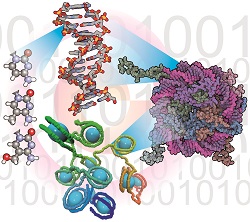DNA – The force is with you
Current simulation procedures using force fields to represent DNA have two major problems. Classical force fields designed to calculate the potential energy of a system of atoms have well-known biases, which limit their accuracy. Moreover, procedures are limited to study systems in the range of 100 base pairs whereas the simplest DNA molecule from prokaryotes, without a nucleus, is one billion times larger. The new gold standard for DNA simulation at the atom level The EU-funded SIMDNA (Advanced multiscale simulation of DNA) project has developed a multiscale simulation technology that resolves the entire range of DNA scales – from the nucleobase at one ten-billionth of a metre to the human genome at the metre level. As Dr Modesto Orozco, research coordinator of the SIMDNA project outlines, ‘The overall goals were to present a continuum of methodologies to represent DNA from the atomistic to the nucleosome level, including short chromatin fibres.’ The SIMDNA team made great progress during the five-year term of the project. At the atomic level, they have ousted the previous gold standard for DNA simulation with the new parmbsc1 force field. Causing a stir in the DNA structure and function arena, opening the facility to the community resulted in more than 350 citations in science journals. Coping with deformation and the mesoscopic model DNA deformation occurs during the communication of DNA with other molecules, its so-called multimodality, as well as a result of epigenetic modifications that usually occur due to external environmental conditions. The researchers have developed and implemented a mesoscopic model to measure scales between atoms and molecules and materials in the order of micrometres during these distortions. The mesoscopic model can also simulate reasonably long pieces of chromatin with nucleosomes, where unique packing ability ensures that the molecule can fit into tight spaces while still being accessible to interaction with other molecules. An example of SIMDNA’s research ingenuity in the face of problems emerged when working with the nucleosome structure. ‘We found poor quality data available regarding the positions of nucleosomes in the fibre. And we partially solved the problem by collecting our own data for a small model system (yeast),’ explains Orozco. Molecules as dynamic information carriers and significance for the future of medicine DNA and RNA aren’t the only way to transfer crucial information that ensures the switching on of the right gene at the right time. Other molecules that store vital data include proteins, in particular, enzymes. The SIMDNA project has also investigated the phenomenon of allosterism, where an enzyme’s activity can be modulated by interaction with small molecules, for example. Allostery can make a world of difference where the action of an enzyme is concerned as its shape can be totally transformed. The researchers looked at several enzymes that act on DNA. One, called relaxase, is involved with the transfer of antibiotic resistance in Staphylococcus aureus during conjugation, when it can pass its genes to neighbouring bacteria. The paper has been published in PNAS. Another two papers on allosterism are under consideration for publication in a high-impact journal. Trying to find boundaries for the wide range of future applications for the SIMDNA technology in biomolecule simulation is difficult, there are literally so many. Orozco points towards a massive effect in the field of complex diseases. ‘I think a point for the future application of these type of [simulation] calculations is the impact they might have on the better understanding of epigenetic-originated diseases, especially in complex pathologies such as cancer.’
Keywords
SIMDNA, DNA, simulation, force fields, enzymes, complex diseases







